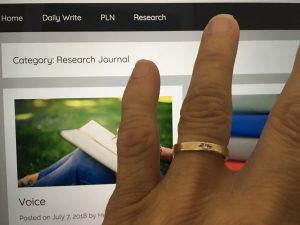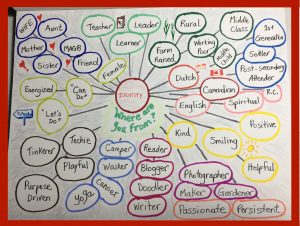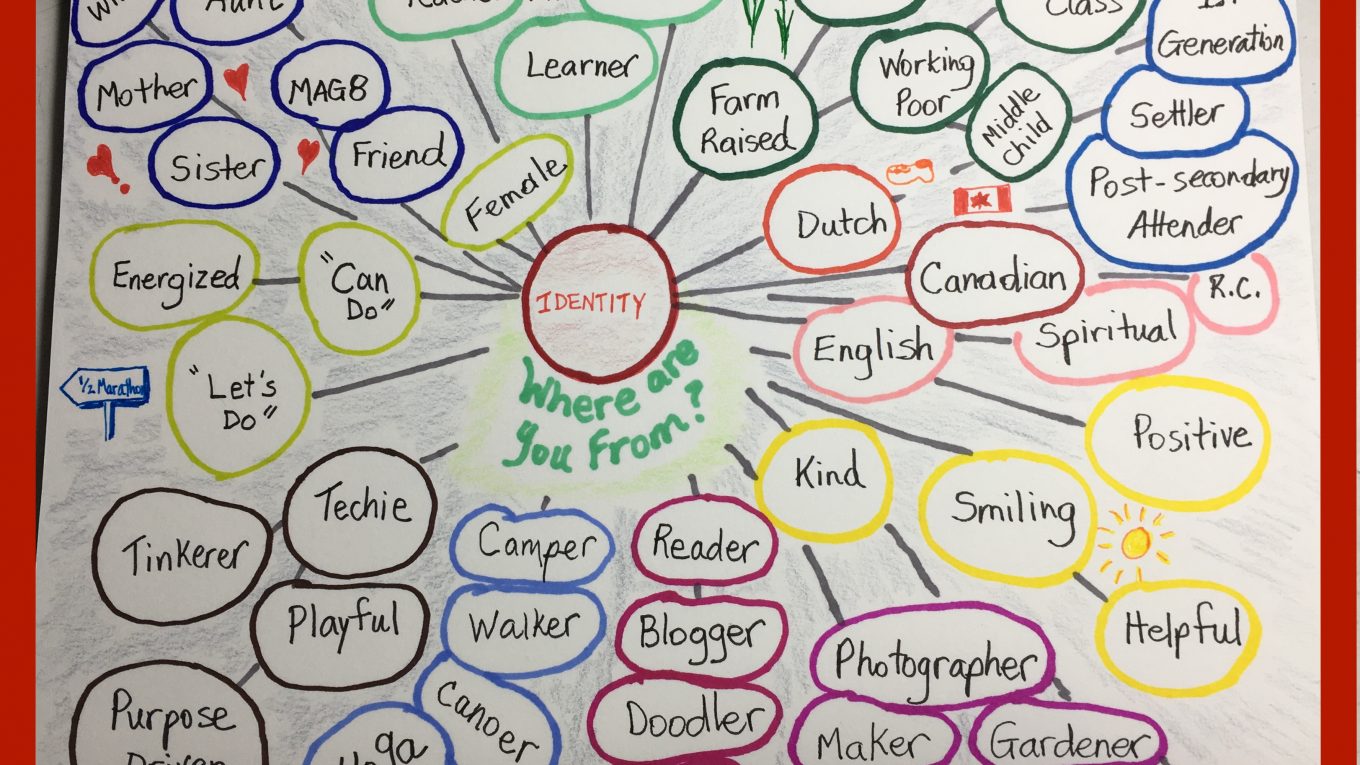What’s My Story?
This is the first submission for the Research Journal assignment in DS1. I’m posting it here with the images included and the links active, to model the multimodal application of academic voice.
What’s THE story? Shelley Moore, in her recorded presentation What’s the Story? shares a compelling example of the importance of examining an image from multiple perspectives. She reveals a personal experience, using a metaphor to look beyond the image of red shoes on a desk, to gain perspective, analyze deeper, and understand the full picture. This has implications for my PhD journey, not only for this analysis of where I’m from, but also for the research yet to be accomplished. I’ll begin this research journal reflection with a personal version of the red shoe metaphor. I’ll connect that to where I’m from, building on activities shared in class this week, and conclude with some complexity in shifting my ‘self’ towards an academic voice.
 I wear my mother’s wedding ring. It’s a physical reminder of the circle that supports me – my husband, family and friends. It’s one small circle, but is a symbolic reminder of the ever present network that brings me to the PhD program. I grappled with my identity as a PhD applicant, and now questioning the image of me as a PhD student, while quietly testing the waters of this shifting identity with close family and friends. Telling others in my circles of trust is difficult but their responses, as I should have predicted, were supportive and heartwarming. Today, I wish my mother had lived long enough to see this wedding band experience what she dreamed of doing. That’s THE story that frames this snapshot.
I wear my mother’s wedding ring. It’s a physical reminder of the circle that supports me – my husband, family and friends. It’s one small circle, but is a symbolic reminder of the ever present network that brings me to the PhD program. I grappled with my identity as a PhD applicant, and now questioning the image of me as a PhD student, while quietly testing the waters of this shifting identity with close family and friends. Telling others in my circles of trust is difficult but their responses, as I should have predicted, were supportive and heartwarming. Today, I wish my mother had lived long enough to see this wedding band experience what she dreamed of doing. That’s THE story that frames this snapshot.
 As a first generation PhD aspirant, I’m stepping out of family traditions, but not going alone. My wedding band is a physical reminder of the support that encircles me. The bigger picture includes the faces of many others on whom I’ll rely in coming years. While this single snapshot image results from the 2C & 2L and identity circles activities done in class, it does not fully represent the circles that originate in the communities, cultures, language and land that surround and support me in this PhD experience.
As a first generation PhD aspirant, I’m stepping out of family traditions, but not going alone. My wedding band is a physical reminder of the support that encircles me. The bigger picture includes the faces of many others on whom I’ll rely in coming years. While this single snapshot image results from the 2C & 2L and identity circles activities done in class, it does not fully represent the circles that originate in the communities, cultures, language and land that surround and support me in this PhD experience.
Acquiring an academic voice is an essential part of becoming a PhD researcher. Reflecting in a research journal is a means to capture snapshots in time, as a record of shift voice. My journaling started the day I was accepted into the PhD program, with a new blog site Step By Step where I’m capturing snapshots of thinking. It started with Let it Begin. I’ll occasionally step back to gain perspective and analyze evidence in order to understand the full story. Here I’m focusing on developing my academic voice through reflection.
On June 20, 2018 I wrote Reflexivity after reading Watt’s (2007) article on becoming a qualitative researcher:
“This practice of reflection is not lost on me, as I begin this PhD experience. I’ve been blogging for years and will now need to consider how this public nature of my writing will fit into the reflective, reflexive and refractory nature of ideas, theories, practices, decisions, methodologies as I negotiate all things shared, stated or kept private. I have the crystal in my hand. Beams of light are streaming through – readings and writings bend through the crystal and are refracting onto new pages, yet to be read, written, and reflected.”
On July 4, 2018 my concern shifted as I wrote Academic Voice:
My current communities of practice may be familiar with my writing voice as a ‘practitioner’ in education. I’ve blogged as an educator for years. I model my blogging style for my students, so it is shaped by the practicalities in the field of education. This new form of writing, the academic formation, is not yet known and, I wonder how it will be recognized. Do I need to share this academic voice in distinct spaces and places, thus creating a binary me, or as Pallas (2001) cautions, a “dissociative scholarly identity” (p. 11)? How will I manage this shift from one voice to another, or can many voices live and exist within the same individual? Will time and practice in writing create a new identity that can merge the practical, reflective voice with the esoteric academic?
My academic voice must be my own, but it will be crafted and shaped by the communities in which I share my writing. Through this process of sharing, critique, and revision, my voice will be subjected to exposure to other academics, many who have been practicing their voices for much longer. Today in class, it was encouraging to hear that the best academic writers stand on the shoulders of those with whom they share their writing, openly inviting critique. This ‘in kind’ exchange with critical friends can certainly be beneficial since this form of sharing is done with trusted colleagues. It’s the peer review from unknown sources or the academic scrutiny of a dissertation committee that currently haunts my thoughts as a novice academic writer.
My concern with this transition toward an academic voice continues in Voice:
In my mind I know it’s not a binary. It’s not an either-or proposition. It’s a transitional scale that will dial up or down depending on circumstance and context. But in my heart, it’s a reluctance to change while still yearning for the change to happen quickly. At this point in time I feel the necessary push-pull and will work to keep my head and heart in synch since this is a transition of my own choosing, supported and encouraged by those in my ‘real life’. For now, I’ll keep my ‘zombified’ self from their view and flip the switch between my academic and real life voice.
As this research journal begins I’m locating myself within the field of academia, specifically the PhD program. These reflections capture an image of complex yet interwoven circles of who I am, where I’m from and how I’m changing. It’s comforting to know that these circles don’t end or begin. This wedding band snapshot will continue to encircle and support my progress. It is THE story … for now.
References
DeWaard, H. (2018, June 20). Reflexivity. [Web log post] Retrieved from https://stepbystep.hjdewaard.ca/blog/researchjournal/reflexivity/
DeWaard, H. (2018, July 4). Academic voice. [Web log post]. Retrieved from https://stepbystep.hjdewaard.ca/blog/researchjournal/academic-voice/
DeWaard, H. (2018, July 7). Voice [Web log post] Retrieved from https://stepbystep.hjdewaard.ca/blog/researchjournal/voice/
Moore, S. (2017, February 17). What’s the story? – Shelley Moore. [Video file]. Retrieved from https://www.youtube.com/watch?v=YLBYLGWBhf8
Pallas, A. (2001). Preparing Education Doctoral Students for Epistemological Diversity. Educational Researcher, 30 (5), 6-11.
Watt, D. (2007). On Becoming a Qualitative Researcher: The Value of Reflexivity. Qualitative Report, 12(1), 82-101.
